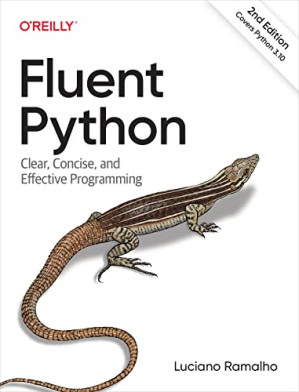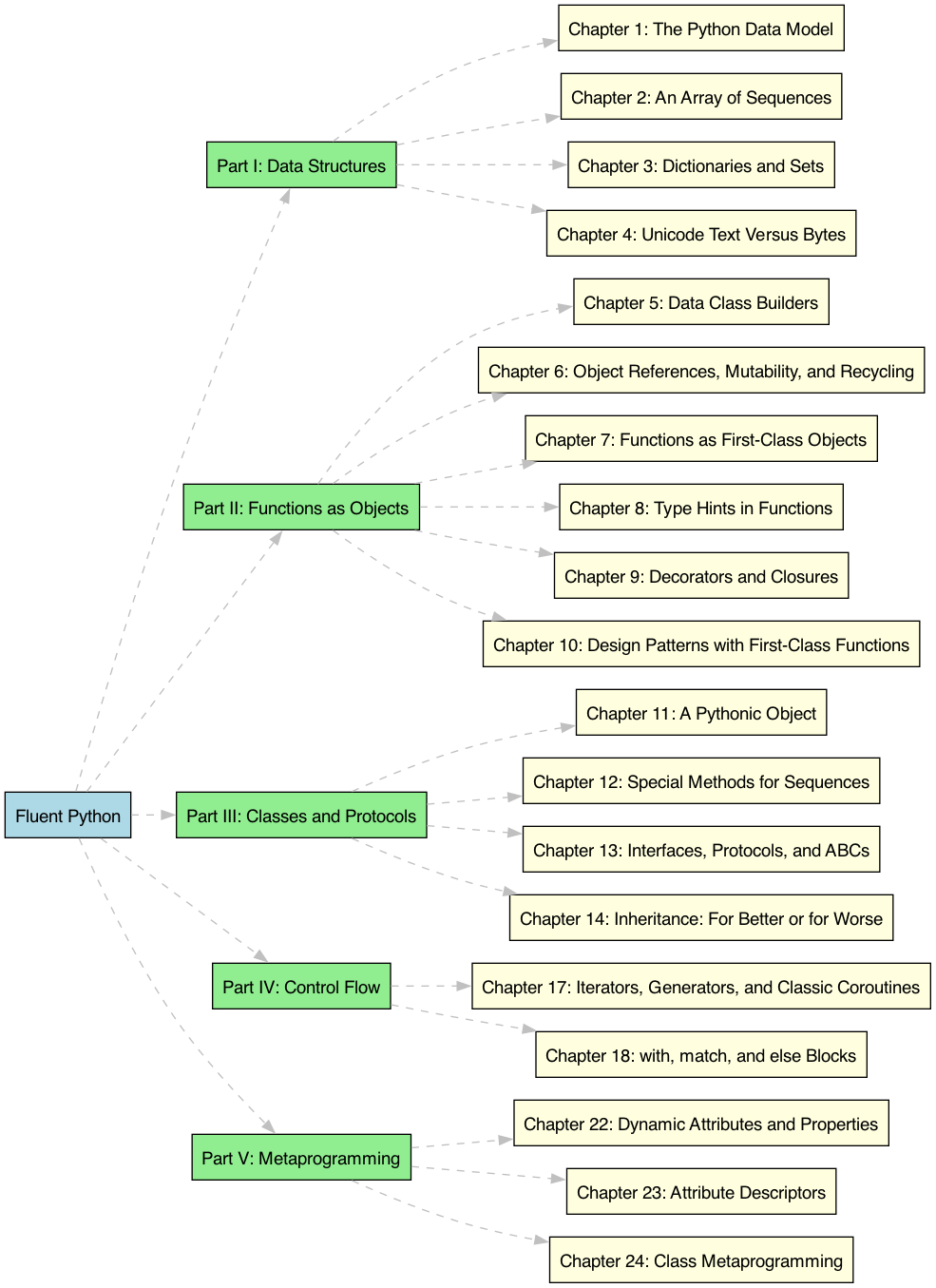Insights from Fluent Python: Clear, Concise, and Effective Programming, second edition
Welcome to our deep dive into Fluent Python by Luciano Ramalho. In this post, we'll explore key concepts and insights from the book that will help you master Python programming. Whether you're a beginner or an experienced developer, this book offers valuable lessons on writing idiomatic Python code.
Fluent Python by Luciano Ramalho is a comprehensive guide that delves into the depths of Python programming, offering insights and practical advice on writing idiomatic and efficient Python code.

Summary

Overview
In-Depth Analysis
The Importance of Pythonic Thinking
"Fluent Python" emphasises the value of writing code that is not only functional but also readable and maintainable. Pythonic code leverages the language's features and idioms, making it intuitive for other developers.
Mastering Data Structures
Understanding Python's data structures is crucial for efficient programming. Ramalho's thorough coverage of lists, tuples, dictionaries, and sets provides a solid foundation for building robust applications.
Advanced Features
The book also explores advanced topics such as decorators, context managers, and metaprogramming. These features allow developers to write more flexible and powerful code.
- Decorators and Closures: Enhancing functions and managing scope.
- Context Managers: Simplifying resource management.
- Metaprogramming: Dynamically creating and modifying classes.
Practical Applications
Real-World Examples
Ramalho includes numerous examples and case studies that demonstrate how to apply Python's features in real-world scenarios. These examples help bridge the gap between theory and practice.
Exercises and Challenges
Each chapter concludes with exercises that reinforce the material and encourage hands-on practice. These challenges are designed to test your understanding and improve your coding skills.
Part I: Data Structures
Chapter 1: The Python Data Model
Ramalho introduces the Python data model, explaining how special methods enable the language's expressive syntax. He emphasises the importance of understanding these methods to fully leverage Python's capabilities.
- Pythonic Card Deck: An example to illustrate special methods.
- Emulating Numeric Types: Techniques for creating numeric types.
- String Representation and Boolean Value: Implementing
__repr__and__bool__.
Chapter 2: An Array of Sequences
This chapter discusses various sequence types in Python, their use cases, and performance characteristics, including list comprehensions and generator expressions.
- List Comprehensions and Generator Expressions: Tools for creating and processing sequences.
- Tuples as Records and Immutable Lists: Different uses of tuples.
- Pattern Matching with Sequences: Introduced in Python 3.10.
Chapter 3: Dictionaries and Sets
Explores Python's mapping types, focusing on dictionaries and sets, their modern syntax, methods, and best practices.
- Modern
dictSyntax and Comprehensions: Enhancements in Python 3. - Handling Missing Keys: Using
defaultdictand the__missing__method. - Set Operations: Practical applications of set theory.
Chapter 4: Unicode Text Versus Bytes
Explains the differences between text (Unicode) and binary data (bytes) in Python, providing strategies for handling encoding and decoding issues.
- Character Issues and Byte Essentials: Basics of text and binary data.
- Normalizing Unicode: Techniques for reliable text comparisons.
- Dual-Mode APIs: Working with both
strandbytes.
Part II: Functions as Objects
Chapter 5: Data Class Builders
Covers the creation and use of data classes in Python, including named tuples and the @dataclass decorator introduced in Python 3.7.
- Classic Named Tuples and
@dataclass: Differences and use cases. - Field Options and Post-init Processing: Advanced data class features.
- Pattern Matching Class Instances: Integration with the new pattern matching syntax.
Chapter 6: Object References, Mutability, and Recycling
Discusses how Python handles object references, mutability, and garbage collection, providing tips for writing efficient and bug-free code.
- Identity, Equality, and Aliases: Understanding object identity and equality.
- Shallow and Deep Copies: How to create copies of objects.
- Garbage Collection: How Python manages memory.
Chapter 7: Functions as First-Class Objects
Explores the concept of first-class functions in Python and how to use them effectively in functional programming.
- Higher-Order Functions: Functions that operate on other functions.
- Anonymous Functions and Callable Objects: Using
lambdaand custom callable objects. - functools.partial: Freezing arguments for function calls.
Chapter 8: Type Hints in Functions
Introduces type hints and gradual typing in Python, explaining how to use them to improve code clarity and maintainability.
- Gradual Typing with Mypy: Static type checking in Python.
- Type Annotations for Functions: Syntax and best practices.
- Generic Types and Protocols: Advanced type hinting features.
Chapter 9: Decorators and Closures
Explains decorators and closures, powerful tools for extending and managing functions.
- Implementing Simple Decorators: How decorators work.
- Closures and
nonlocalDeclaration: Managing state in nested functions. - Memoization with
functools.lru_cache: Caching function results.
Chapter 10: Design Patterns with First-Class Functions
Covers design patterns that leverage first-class functions, enhancing code flexibility and reusability.
- Strategy Pattern: Function-oriented design for flexibility.
- Command Pattern: Encapsulating actions as objects.
- Decorator-Enhanced Strategy Pattern: Combining patterns for powerful designs.
Part III: Classes and Protocols
Chapter 11: A Pythonic Object
Discusses object-oriented programming in Python, focusing on idiomatic practices and advanced features.
- Object Representations: Implementing
__repr__and__str__. - Vector Class Redux: Enhancing a simple class with advanced features.
- Using
__slots__: Saving memory with__slots__.
Chapter 12: Special Methods for Sequences
Explores how to implement custom sequence types using special methods.
- Vector: A User-Defined Sequence Type: Creating a custom sequence.
- Slicing and Dynamic Attribute Access: Enhancing sequence functionality.
- Hashing and Equality: Implementing
__hash__and__eq__.
Chapter 13: Interfaces, Protocols, and ABCs
Explains the use of abstract base classes (ABCs) and protocols to define interfaces and ensure code consistency.
- Structural Typing with ABCs: Defining interfaces.
- Static Protocols: Designing and using static protocols.
- Runtime Checkable Protocols: Ensuring type safety at runtime.
Chapter 14: Inheritance: For Better or for Worse
Covers the benefits and pitfalls of inheritance in Python, advocating for composition over inheritance.
- The
super()Function: Usingsuper()effectively. - Multiple Inheritance and MRO: Understanding the method resolution order.
- Mixin Classes: Reusing code with mixins.
Part IV: Control Flow
Chapter 17: Iterators, Generators, and Classic Coroutines
Explores iterators, generators, and coroutines in Python, essential tools for managing control flow and asynchronous programming.
- Creating Iterators and Generators: Building custom iterators.
- Coroutines and
yield: Using coroutines for asynchronous programming. yield fromandasync/await: Advanced coroutine techniques.
Chapter 18: with, match, and else Blocks
Discusses context managers, the new pattern matching syntax, and the else block in control flow structures.
- Context Managers and
withBlocks: Simplifying resource management. - Pattern Matching in Python 3.10: Using
matchfor powerful control flow. elseBlocks in Loops and Try Statements: Enhancing control flow readability.
Part V: Metaprogramming
Chapter 22: Dynamic Attributes and Properties
Covers advanced techniques for dynamic attribute management and property handling in Python.
- Dynamic Attribute Access: Working with dynamic attributes.
- Computed Properties: Using properties for computed values.
- Property Factories: Creating properties dynamically.
Chapter 23: Attribute Descriptors
Explains the use of descriptors for managing attributes, a powerful feature for advanced object-oriented programming.
- Implementing Descriptors: Creating custom descriptors.
- Overriding and Nonoverriding Descriptors: Understanding descriptor behavior.
- Descriptor Usage Tips: Best practices for using descriptors.
Chapter 24: Class Metaprogramming
Explores metaprogramming techniques in Python, including the use of metaclasses to dynamically modify class behavior.
- Creating Metaclasses: Building and using metaclasses.
- Enhancing Classes with Metaclasses: Practical applications.
- Modern Features and Metaclasses: Simplifying metaprogramming with new Python features.
Key Takeaways
- Understanding Special Methods: Special methods are crucial for writing idiomatic Python code.
- Leveraging Python's Data Structures: Efficient use of lists, tuples, dictionaries, and sets can significantly improve code performance.
- Functional Programming Techniques: Higher-order functions, decorators, and closures offer powerful tools for flexible code design.
- Advanced Object-Oriented Programming: Mastering inheritance, mixins, and protocols enhances object-oriented programming.
- Control Flow and Asynchronous Programming: Iterators, generators, and coroutines are essential for managing complex control flows.
- Metaprogramming: Dynamic attributes, descriptors, and metaclasses allow for advanced code customization and optimization.
Personal Reflections
Reading Fluent Python has been an enlightening journey into the depths of Python programming. Luciano Ramalho's detailed explanations and practical examples have greatly enhanced my understanding of Python's advanced features and best practices. The emphasis on writing clear, idiomatic code resonates with my experiences and aspirations as a developer.
Conclusion
Fluent Python by Luciano Ramalho is an essential resource for any Python developer seeking to deepen their understanding of the language and improve their coding skills. The book's comprehensive coverage of Python's features, combined with practical examples and exercises, makes it a valuable guide for mastering Python. By embracing the principles and techniques outlined in this book, developers can write more efficient, readable, and maintainable code.